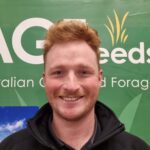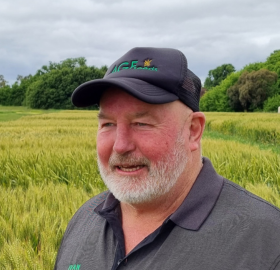We have the variety and range to find the perfect grass for any situation.
A deep-rooted perennial grass of high to moderate drought tolerance (depending on cultivar), native to Northern Europe and the Mediterranean regions. The first varieties were introduced to Australia from Northern Africa in the 1930’s. The perceived lack of quality has been an issue for some time. Some new cultivars are of higher quality. Persistence and quality can be further improved by attention to grazing management. There are two distinct types: Northern European types that are summer active and Mediterranean types that are summer dormant. Cocksfoot needs reasonably well-drained soils to persist, and will tolerate soils of very low pH.
400-550mm
Summer Dormant
Summadorm is a hardy deep rooted Mediterranean type cocksfoot, demonstrating excellent summer dormancy compared to other Mediterranean types, and is proven to show increased persistence in medium rainfall zones. It also continues to produce strong winter yields, assisting in filling the winter and early spring feed gap.
500mm
Sheep + Beef
Summer
Active
A late flowering variety with prostrate, growth habit. Bred for a low crown. It has proven to be a durable variety, with a fit in medium to high rainfall zones in sheep and beef pastures.
600mm
Sheep, Beef & Dairy
Summer Active
A late flowering variety with semi erect growth habit, high palatability and persistence. Lazuly is suitable for sheep, beef and dairy systems, being softer and more palatable to animals.
Bromes are deep-rooted grasses; they are very heat and drought tolerant and produce high quality nil endophyte pastures. They prefer free-draining soils and are intolerant of pugging and being waterlogged. The bromes have been split into three distinct types; 1. Prairie Grass (high production over a short period) 2. Pasture Brome (medium term pasture) 3. Grazing Brome (more persistent long term pasture
650mm+
Reseeds
Jeronimo is a new highly winter active prairie grass with a broad fit for pasture systems where rotational grazing is used. It has similar maturity to Matua and has excellent capacity for reseeding into pasture swards. It has much improved autumn/ winter activity to ensure more feed when it is most needed.
A deep-rooted perennial grass native to Europe, the Mediterranean region, and Asia. It is suited to soils of medium to high fertility, will tolerate waterlogging and moderately saline conditions. There are two distinctively different types, summer active and summer dormant. Summer active tall fescues have the ability to out produce perennial ryegrass during summer and require periodic summer rainfall or irrigation. Summer dormant types have the ability to persist in areas of very low rainfall.
600mm+
Summer Active
Soft Leaf
Finesse-Q is a high yielding, densely tillered, soft-leaf fescue with semi-late heading. It is extremely persistent due to its dense nature and has no fescue endophyte. It has an intermediate growth pattern better suited to much of Australia’s oceanic climate, and has performed well in trials sown here in 2006. Its tiller density and high leaf quality make it well suited to dairy, beef and sheep. Its lack of endophyte makes it also suited to grazing by horses, goats and alpacas.
350mm+
Summer Dormant
A Mediterranean tall fescue with high winter production and summer dormancy. It is ideal for low summer rainfall areas and shows good persistence.
Phalaris is a deep-rooted perennial grass native to the Mediterranean region, once established it is drought tolerant and persistent. Quality can be maintained through correct management. Phalaris has very low seedling vigour and care should be taken at establishment. It will persist on a wide range of soil types including heavy waterlogged soils. Phalaris is the most sensitive of the temperate grasses to acid soils, and performs best on neutral soils. Cultivars available include both winter active and winter dormant varieties.
450mm
Erect Growth
Mate is a highly winter active phalaris bred in Argentina with excellent autumn to spring forage production and good persistence. It has good seedling vigour and high autumn/ winter forage yields. Mate is about 2 weeks earlier flowering than Holdfast. It can also be sown as the sole perennial grass with sub clover, or in a mix with summer active cocksfoot varieties for all year round feed. It is also suited to sowing at 0.5-1kg/ha with lucerne.
450mm+
Grazing Tolerant
Phalaris bred for increased grazing tolerance over Holdfast Phalaris. Has excellent winter activity and seedling vigour with exceptional dry matter production. Adapted to a greater range of soil types than holdfast.
500mm+
Economical
Holdfast is a winter activity variety with a low level of summer dormancy, similar to the levels in Australian. At the time of Holdfasts release in the 90’s it was slightly more tolerant of soil acidity than other cultivars available at that time.
450mm+
Acidic Soil Tolerant
A new Phalaris cultivar bred for increased tolerance to acid soils. Advance AT can tolerate pH > 3.8 (CaCl2) and exchangeable aluminium of 20-50%.

Gippsland, Yarra Valley, SW Vic, & Lower SE SA
0409 776 126
rhys.cs@agfseeds.com.au

Northern NSW & Queensland
0499 456 263
will.bazley@agfseeds.com.au

Victorian Mallee & South Australia
0448 863 169
craig.altmann@agfseeds.com.au

South East NSW & North East Victoria
0491 219 291
cooper.lambden@agfseeds.com.au

SW Vic, Central Vic, SE South Australia, Murray NSW & Tasmania
0497 432 157
ivan.pyke@agfseeds.com.au

Key Accounts & Customer Service
03 5345 6262
clay.mabilia@agfseeds.com.au
NOTICE: Although the information and recommendations in this guide are presented in good faith and believed to be correct, AGF Seeds Pty. Ltd. makes no representations or warranties as to the completeness or accuracy of Information. Information is supplied upon the condition that the persons receiving same will make their own determination as to its suitability for their purposes prior to use. In no event will AGF Seeds Pty. Ltd. be responsible for any damages or loss of any nature whatsoever resulting from the use of or reliance upon Information supplied in this guide.